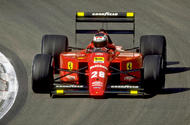We take a look at Ferrari’s F1 challenger
Enzo and his son Piero often disagreed as they co-ruled Ferrari in the 1980s, and the elder man might have retrospectively wished that he had lost the argument over the Scuderia’s next Formula 1 car as the ban on turbocharging approached.
Chief engineer John Barnard had resolved “to take as many technical steps forward as I thought it safe to take” and thus created a car with a new 65deg 3.5-litre V12 engine; a gearbox shifting by an electronically controlled servo-motor; a carbonfibre chassis with entirely separate bodywork; and electronically controlled suspension using an on-board Marelli computer.
Subscribe to the Autocar Archive today
The 640 had originally been meant for introduction in the 1988 season, but so advanced was it that it didn’t arrive until the first race of 1989, and even then with severe doubts about reliability.
These proved unfounded in Brazil as Nigel Mansell piloted the first semi-automatic F1 car to victory, before the innovative carbonfibre structure helped to save Gerhard Berger when he crashed in Italy.
Reliability was generally poor, though, with Berger finishing just three of 15 races. If only this could have been sorted, Ferrari would surely have won the title that year.
Source: Autocar
